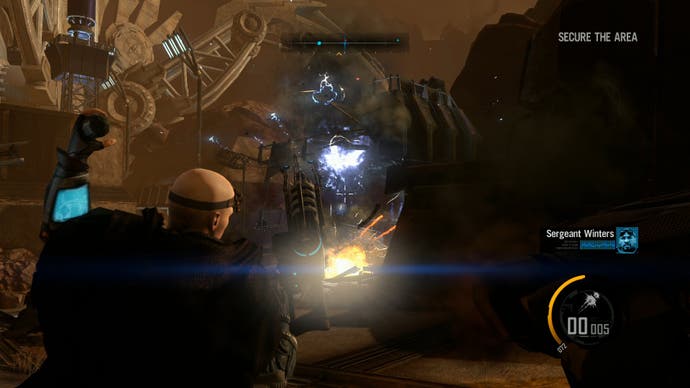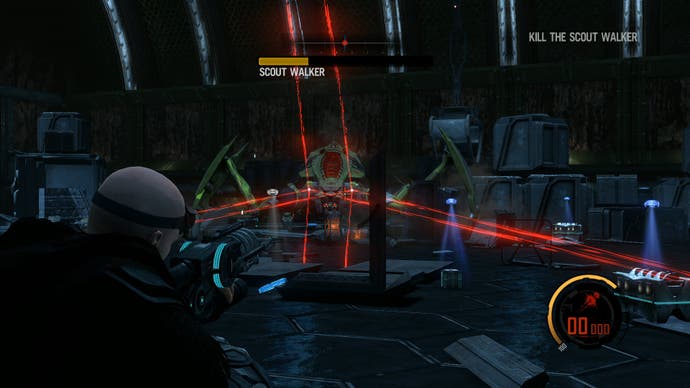Face-Off: Red Faction: Armageddon
Destruction derby.
This setup of delivering as many frames as possible results in the player getting the fastest controller feedback available, when the engine is able to deliver a relatively high frame-rate (between 40-50FPS). However, when the engine is unable to do this - during taxing scenes where the screen is filled with enemies and particle effects - the game slows down considerably, dropping a great many frames and impacting heavily on controller response, thus creating an unhealthy amount of latency between button presses or turns of the analogue sticks. It's not a great situation for players to be in, and serves to disconnect them from the action.
Looking at the video, and it's pretty hard to conclude that one version performs better than the other across a general run of play, as both 360 and PS3 code seem to be similarly affected. We do see the PS3 game hitting both the highs and the lows slightly more often than the 360 in very closely matched scenarios, maybe having the mildest of advantages. Mostly though, they are pretty much like for like.
If what we have here is a case of a game compromised by the limitation of console resources, the PC version should allow us to see Red Faction: Armageddon at the height of its potential. If you can't bump up the resolution and play the games at silky smooth frame-rates, then it's simply a case of throwing more power at the problem until it goes away.
In direct comparison with the console versions, the most noticeable benefit comes with the ability to render a native 720p output, thus preserving overall image quality while allowing the artwork to shine. Without the need to run at a sub-HD resolution, the crisp native resolution on the PC sees subtle details in the textures coming through unscathed, with none of the blur seen on the 360 and PS3 versions, while use of up to 8x MSAA delivers a cleaner presentation with far less aliasing - although oddly enough some sections of the game weren't massively improved over the PS3 code and its use of MLAA in this regard.
Further enhancements include higher-precision effects and the use of screen space ambient occlusion (SSAO) in adding a little extra depth to some scenes. Higher levels of anisotropic filtering deliver much greater clarity to texture detail on parts of the environment situated far away from the camera. Shadow quality is notably better, with edges looking sharper and more defined. The overall result is simply a game that is far more pleasing to look at - and smoother to play.
On a quad-core i5 and NVIDIA GTX 460 setup, we were maxing out the game on all settings and running it v-synced in 720p, gaining a frequently fluid 60FPS update. There was some drops down to the 45fps mark in similarly stressful situations as seen in our console performance video, but the end result was a vast improvement over and above the 360 and PS3; controller feedback was consistently responsive resulting in a more enjoyably playable experience all round.
Curiously, it seems that the computer version shares the same lighting setup as the PS3 game, with additional lights in play above the 360, along with the extra detailed texture found on the Microsoft system. Interestingly, the cut-scenes in the PC version appear identical to those seen on both the consoles. We see the similarly blurred, highly compressed footage being used, with no added benefits whatsoever.


There's no question about the superiority of the PC code over and above the console versions of Armageddon, but the real test comes when running the game in 1080p. It's basically a case of whether or not the extra resolution actually provides any tangible benefits to the artwork and visual effects compared to what we are seeing in 720p. Arguably, there's no additional boost in raw detail, asset-wise, but the enhanced clarity and sharpness of the image certainly adds to the visual appeal of the game.
More pixels to render generally means lower levels of performance, so in this case we are no longer looking at a baseline 60FPS update which dominated our tests at 720p. Instead, a consistent 30-40FPS is commonplace throughout, but with a few small jolts above and below on our GTX 460 set-up. Maintaining 1080p60 at max settings requires something a little meatier - a GTX 560Ti or Radeon HD 6950.
The game appears to be optimised for dual-core processors, with little to be gained by jumping up to a quad-core. However, utilising a Core i3, i5 or i7 processor gives a significant gain over an older-generation Core 2 Duo or Core 2 Quad, to the point where a base-level Core i3 dual-core CPU running at 2.93GHz effortlessly outperforms an older quad-core Intel CPU operating at much the same clock speed. The overall conclusion is that while the PC version is undeniably superior to the console game in many respects, you're going to require a powerful computer to get the most out of it.
As it stands, Red Faction: Armageddon is a decent enough shooter, but one that fails to really live up to its potential. Clearly, the GeoMod technology is worth evolving still further for future Red Faction games - but it's evident that any evolution in the destruction really needs to be matched by an equivalent boost in the ingenuity of the game design. In the here and now, Red Faction: Armageddon is a solid game, but not an outstanding one. However, there's little doubt that its charms are best appreciated on PC.
In contrast, while the console versions are still highly playable, they aren't as attractive in comparison. Both are pretty evenly matched, with the differences between the two having very little impact on which version you should go for. The 360 game is slightly sharper, with a little more texture detail in places, while the PS3 offers up mildly better anti-aliasing (though at the expense of image clarity) along with a different lighting set up in places. In the final analysis, both come equally recommended, but really you should be looking to pick up the PC version - if you have a machine capable of running it on high quality settings - for the best possible gameplay experience.
Article by David Bierton.

